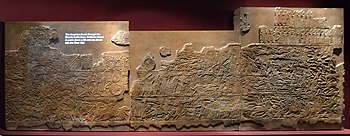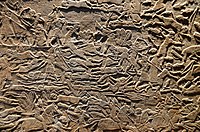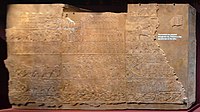
Chaldea was a small country that existed between the late 10th or early 9th and mid-6th centuries BC, after which the country and its people were absorbed and assimilated into the indigenous population of Babylonia. Semitic-speaking, it was located in the marshy land of the far southeastern corner of Mesopotamia and briefly came to rule Babylon. The Hebrew Bible uses the term כשדים (Kaśdim) and this is translated as Chaldaeans in the Greek Old Testament, although there is some dispute as to whether Kasdim in fact means Chaldean or refers to the south Mesopotamian Kaldu.

The 7th century BC began the first day of 700 BC and ended the last day of 601 BC.

Babylonia was an ancient Akkadian-speaking state and cultural area based in the city of Babylon in central-southern Mesopotamia. It emerged as an Akkadian populated but Amorite-ruled state c. 1894 BC. During the reign of Hammurabi and afterwards, Babylonia was retrospectively called "the country of Akkad", a deliberate archaism in reference to the previous glory of the Akkadian Empire. It was often involved in rivalry with the older ethno-linguistically related state of Assyria in the north of Mesopotamia and Elam to the east in Ancient Iran. Babylonia briefly became the major power in the region after Hammurabi created a short-lived empire, succeeding the earlier Akkadian Empire, Third Dynasty of Ur, and Old Assyrian Empire. The Babylonian Empire rapidly fell apart after the death of Hammurabi and reverted to a small kingdom centered around the city of Babylon.
This article concerns the period 649 BC – 640 BC.
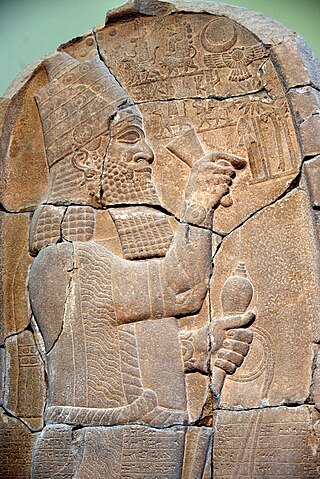
Esarhaddon, also spelled Essarhaddon, Assarhaddon and Ashurhaddon was the king of the Neo-Assyrian Empire from the death of his father Sennacherib in 681 BC to his own death in 669. The third king of the Sargonid dynasty, Esarhaddon is most famous for his conquest of Egypt in 671 BC, which made his empire the largest the world had ever seen, and for his reconstruction of Babylon, which had been destroyed by his father.

Ashurbanipal was the king of the Neo-Assyrian Empire from 669 BC to his death in 631. He is generally remembered as the last great king of Assyria. Ashurbanipal inherited the throne as the favored heir of his father Esarhaddon; his 38-year reign was among the longest of any Assyrian king. Though sometimes regarded as the apogee of ancient Assyria, his reign also marked the last time Assyrian armies waged war throughout the ancient Near East and the beginning of the end of Assyrian dominion over the region.

Šamaš-šuma-ukin, was king of Babylon as a vassal of the Neo-Assyrian Empire from 668 BC to his death in 648. Born into the Assyrian royal family, Šamaš-šuma-ukin was the son of the Neo-Assyrian king Esarhaddon and the elder brother of Esarhaddon's successor Ashurbanipal.

The Neo-Assyrian Empire was the fourth and penultimate stage of ancient Assyrian history. Beginning with the accession of Adad-nirari II in 911 BC, the Neo-Assyrian Empire grew to dominate the ancient Near East and parts of Caucasus, North Africa and East Mediterranean throughout much of the 9th to 7th centuries BC, becoming the largest empire in history up to that point. Because of its geopolitical dominance and ideology based in world domination, the Neo-Assyrian Empire is by many researchers regarded to have been the first world empire in history. It influenced other empires of the ancient world culturally, administratively, and militarily, including the Neo-Babylonians, the Achaemenids, and the Seleucids. At its height, the empire was the strongest military power in the world and ruled over all of Mesopotamia, the Levant and Egypt, as well as parts of Anatolia, Arabia and modern-day Iran and Armenia.
The Battle of Halule took place in 691 BC between the Assyrian empire and the rebelling forces of the Babylonians, Chaldeans, Persians, Medes, Elamites and Aramaic tribes.

The conquest of Elam by the Neo-Assyrian Empire took place between 655 and 639 BC.

The timeline of ancient Assyria can be broken down into three main eras: the Old Assyrian period, Middle Assyrian Empire, and Neo-Assyrian Empire. Modern scholars typically also recognize an Early period preceding the Old Assyrian period and a post-imperial period succeeding the Neo-Assyrian period.

The Sargonid dynasty was the final ruling dynasty of Assyria, ruling as kings of Assyria during the Neo-Assyrian Empire for just over a century from the ascent of Sargon II in 722 BC to the fall of Assyria in 609 BC. Although Assyria would ultimately fall during their rule, the Sargonid dynasty ruled the country during the apex of its power and Sargon II's three immediate successors Sennacherib, Esarhaddon and Ashurbanipal are generally regarded as three of the greatest Assyrian monarchs. Though the dynasty encompasses seven Assyrian kings, two vassal kings in Babylonia and numerous princes and princesses, the term Sargonids is sometimes used solely for Sennacherib, Esarhaddon and Ashurbanipal.

Teumman was a king of the ancient kingdom of Elam, ruling it from 664 to 653 BCE, contemporary with the Assyrian king Ashurbanipal. In various sources, the name may be found spelled as Te’umman, Teumann, or Te-Umman. For a time, "many scholars, beginning with G.G. Cameron," believed him to have been the Tepti-Huban-Inshushinak mentioned in inscriptions, although this view has since fallen from favor.

Ummanigash was briefly a ruler in the ancient kingdom of Elam, ruling after the beheading of his predecessor Teumman in 653. He ruled part of Elam while his brother, Tammaritu, ruled another. He is also referred to as Humban-nikash II and Khumban-nikash II.
Tammaritu II was the ruler of Elam from 652 until 650 or 649 BC. After the brief reigns of Indabibi and Humban-haltash III, Tammaritu II was briefly restored to power in 648. Tammaritu II was the son of Tammaritu I and the successor of Ummanigash, his uncle.
Indabibi was a ruler of ancient Elam in 649 BCE and perhaps 648. He is sometimes referred to as Indabigash. He was the successor of Tammaritu II and the predecessor of Humban-Haltash III. Elam was located to the east of the more powerful Assyrian Empire, and the reign of Indabibi occurred during the reign of Assyrian king Ashurbanipal.
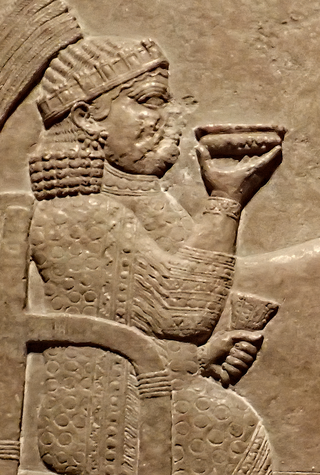
Libbāli-šarrat was a queen of the Neo-Assyrian Empire as the primary consort of Ashurbanipal. Libbāli-šarrat married Ashurbanipal before he became king, probably in 672 BC, and may have lived beyond her husband's death, as documents from the reign of her probable son, Ashur-etil-ilani reference the "mother of the king". Libbāli-šarrat enjoys the distinction of being the only known individual from ancient Assyria who was not a king to be depicted holding court since she is depicted in one of Ashurbanipal's reliefs as hosting him at dinner in the palace garden, surrounded by her own female servants.

The Rassam cylinder is a cuneiform cylinder, forming a prism with ten faces, written by Neo-Assyrian king Ashurbanipal in 643 BCE. The 7th century BCE cylinder was discovered in the North Palace of Nineveh by Hormuzd Rassam in 1854, hence its name. It is located in the British Museum.

Tammaritu I, son of Urtak, was briefly a ruler in the ancient kingdom of Elam, ruling after the beheading of his predecessor Teumman in 653. He ruled part of Elam while his brother, Ummanigash, ruled another.

Tammaritu was a prince of Elam and son of Teumman, king of the ancient kingdom of Elam, who ruled from 664 to 653 BCE, and was a contemporary with the Assyrian king Ashurbanipal. In various sources, the name may be found spelled as Te’umman, Teumann, or Te-Umman. For a time, "many scholars, beginning with G.G. Cameron," believed him to have been the Tepti-Huban-Inshushinak mentioned in inscriptions, although this view has since fallen from favor.
